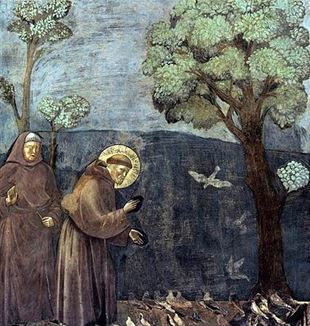
Our Commmon Home
Recovering wonder at “the gift of creation”: the only way to recover our sense of personal responsibility. Amidst the pages of Laudato Si’, Fr. Paolo Martinelli, Capuchin and Auxiliary Bishop of Milan, finds a call to holiness.The Pontiff who, for the first time in the history of the Church, took the name of the patron of Assisi, took for the title of his second encyclical the words Laudato Si’, a reference to the Canticle of Brother Sun written by Saint Francis. The Holy Father offers specific points to summarize the dramatic situation of the environment (“What is happening in our common home,” 17-61), which calls for a renewed responsibility among men and women (“Lines of approach and action,” 163-201); he goes into detail regarding the situation on a global level, and delves into issues of economics and finance; he notes the heavy influence of a globalized technocracy; and he denounces the severe and widespread inequality in the access to natural resources, especially with regards to the poor. Through all these factors he demonstrates the “human roots of the ecological crisis” (101-136). We should all be grateful to him for his evangelical frankness.
At the Source of the Disorder
It’s important that we recognize that the heart of his invitation is to a conversion with the goal of an integral ecology (137-162), which requires a genuine ecology of humanity–as Benedict XVI has already described–and of daily life (147-155). It is in these pages that Francis invites us to action: to make courageous decisions and to find new lifestyles characterized by sobriety, solidarity, and sharing resources.
The source of his proposal lies in the Gospel of Creation (62-100), through which the light of faith offers “ample motivation to care for nature and for the most vulnerable of their brothers and sisters” (64). He encourages an education to a deeper ecological spirituality (203-246), since “the teachings of the Gospel have direct consequences for our way of thinking, feeling, and living” (216).
Through the explicit references to his life, Francis of Assisi becomes an archetype and constant reminder throughout the encyclical. The saint shows us “that an integral ecology calls for openness to categories which transcend the language of mathematics and biology, and take us to the heart of what it is to be human” (11). Francis of Assisi, as a witness and promoter of fraternity with all creation, is presented as the antithesis of contemporary man’s extreme individualism.
In giving this perspective, the Holy Father responds to the unfounded accusations, made in many cultural realms, that Judeo-Christian tradition is the at the root of unbridled exploitation of nature, inasmuch as it gives humankind “dominion” over creation. In reality, the Biblical narrative reminds us that “human life is grounded in three fundamental and closely intertwined relationships: with God, with our neighbor, and with the earth itself” (66). God entrusts creation to the care and custody of mankind. Scripture describes “a relationship of mutual responsibility between human beings and nature. Each community can take from the bounty of the earth whatever it needs for subsistence, but it also has the duty to protect the earth and to ensure its fruitfulness for coming generations” (67).Therefore, it becomes clear that our disordered ecology is in fact the result of the loss of a genuinely Biblical view of creation.
The Pope reminds us that reality is not simply “nature,” but is created: this means that nothing on earth is mere material to be manipulated. The nature of reality is always gift.At the same time, the concept of creation demystifies nature to a certain extent. On this point, Francis reminds us that life becomes disordered when we lose our own sense of being created. Even the compulsive consumption of created things brought about by man seems to “demand of them something which they, in their smallness, cannot give us” (88). The creations of the Infinite Mystery are signs.Saint Francis’s genius is precisely in how he saw every creature within the relationship with God: “Whenever he would gaze at the sun, the moon or the smallest of animals, he burst into song, drawing all other creatures into his praise” (11).Equally thought provoking is the Pope’s reflection on the sacramental dimension of ecology; the connections between creation, the work of human hands, and God’s action in time and space. In the Sacraments, elements of creation become expressions of divinity: “The Sacraments are a privileged way in which nature is taken up by God to become a means of mediating supernatural life” (235). This happens in a unique way in the mystery of the Eucharist.
Healing the Rupture
It’s in the Blessed Sacrament that we see the “fruit of the earth and the work of human hands,” and the action of God who turns bread and wine into the body and blood of Christ. This helps us to glimpse the sacramental dimension of the entireChristian life and its anthropological implications: reality is the place where the work of human hands meets the action of God, both ordered to the recapitulation of all things in Christ. This section lays the groundwork for the strikingly beautiful pages of the encyclical that explain the Trinitarian structure of all creatures. All creation bears the mark of the Most Holy Trinity. The Franciscan theologian Bonaventure, cited by Pope Francis, affirms that, before the rupture of sin, man was able to contemplate the mark of the Trinity in every creature. This is the gaze recovered in the eyes of a saint.
As the Holy Father reminds us, “It’s significant that the harmony which Saint Francis of Assisi experienced with all creatures was seen as a healing of that rupture” (66). Those who have, by grace, recovered the relationship with Christ, also recover the awe at the gift of creation and a sense of personal responsibility.
Ultimately, what this encyclical calls us to is holiness: the true ideal of humanity and society.